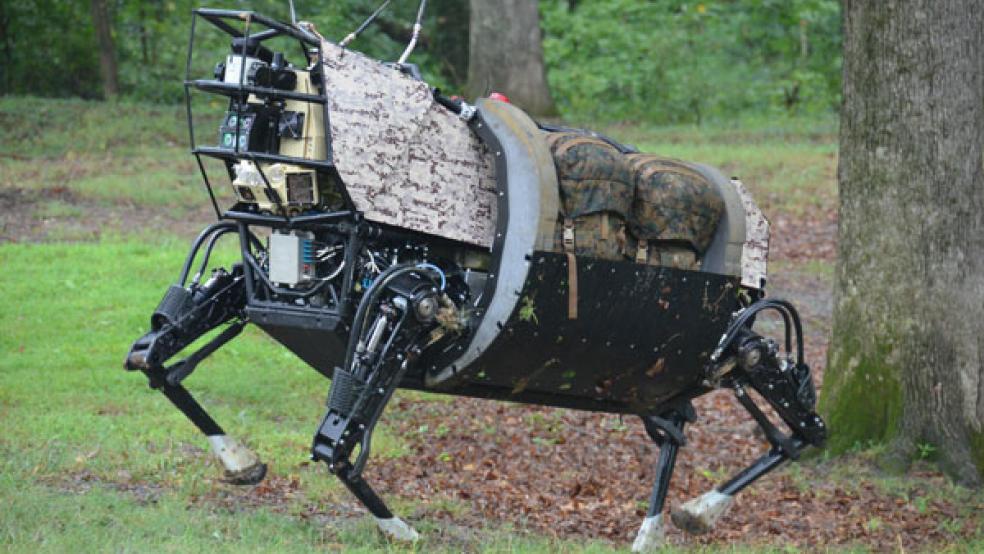Google (NASDAQ:GOOG) managed to snap up half a dozen innovative start-ups for robots before its biggest buy of all caught the world's attention. Its purchase of Boston Dynamics in December 2013 blew the lid off -- or would have, if Google hadn't been so characteristically closed-mouthed about its intentions.
Boston Dynamics has built some truly awesome robots for use by the US military, and even if we can't see them in action in the desert, millions have watched them show off their moves on YouTube.
There's the humanoid Atlas, who looks like he really is prepared to hold up the world, and the Cheetah, which can run up to 29 miles an hour. BigDog can navigate a variety of terrain and follow voice commands. Sand Flea leaps tall buildings.
Related: Robots to Replace Troops on the Battlefield
These are not the killer robots of our nightmares. They apparently are used mostly as advance scouts, monitoring situations on the ground with greater efficiency than humans and, of course, less danger of loss of life.
Google has indicated that it will not pursue further military contracts after completing a couple of prior commitments made by Boston Dynamics. The company doesn't need the money, or the controversy, that comes with military projects.
And that's pretty much all it has said about its intentions for Boston Dynamics and the other robotics companies that now operate under the auspices of Google X, the secretive division of the company that's devoted to long-term research projects.
But this is no "moonshot," the term Google uses to define projects that are too ambitious and too far in the future for its company's quarterly results-focused investors to appreciate. After years of languishing in the realm of sci-fi, robots are finally lurching into the real world.
Some of the credit has to go to the US Department of Defense, which funded robot development for its own needs. Now Google will be developing new generations of Cheetahs and BigDogs with industrial or even home purposes built in.
Their actual construction has become cheaper and easier due to a generation of improvements in mobile technology. Sensors, batteries, chips, and voice activation technology all make robots, as well as cell phones, work.
Now that they're part of Google, the robot-builders have access to the vast stores of data and the deep algorithm-writing skills that are the company's stock in trade.
And that makes robots and Google seem like a natural and even an eminently practical fit.
In addition to Boston Dynamics, Google's other acquisitions have made some very real achievements in robotics. They include:
- Schaft Inc., founded in 2011 to build robots that could assist in the response to the Fukushima nuclear disaster. The company has built a person-sized robot that can climb ladders, clear debris, and connect hoses.
- Industrial Perception, Inc. created the technology for 3-D vision-guided robots. Capable of recognizing and sorting objects, they are intended for use in manufacturing and logistics.
- Meka Robotics built the "human-safe, human-soft" M1 Mobile Manipulator, a model designed to work alongside humans at home or in the workplace. It's developing a robot head that's capable of facial expressions so that it can interact better with humans.
- Bot & Dolly explores the use of robotics as a creative medium. The company is best known for enabling the weightless scenes in the movie Gravity.
Related: Is This the Breakthrough Moment for Google Glass?
Google's interest in robotics may well have coincided with its hiring a year ago of Ray Kurzweil. A near-legendary figure, Kurzweil has many inventions to his credit, but he's best known for his exploration of the frontiers of artificial intelligence.
At age 66, Kurzweil has 19 honorary doctorates, but he got his first real job just last year as Google's director of engineering. As is detailed in a profile in The Guardian, he continues to believe that computers will achieve something resembling consciousness -- not in the distant future, but by about 10 years from now.
That would be a truly amazing achievement. But then again, a more prosaic product would do for most of us. Who wouldn't want a little robot sidekick to take care of all the mundane stuff?
This article originally appeared at Minyanville. Read more from Minyanville:




